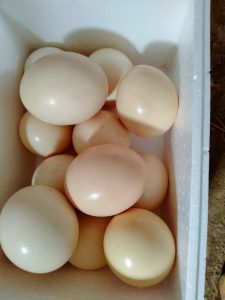
1. Origin and Main Breeding Regions of Ostrich in Vietnam
Ostriches are not native to Vietnam. They were introduced to the country in the 1990s, initially for research and livestock development. After a period of trials, it was observed that ostriches adapted well to Vietnam’s climate, and ostrich farming models gradually expanded.
Currently, large-scale ostrich farms are primarily concentrated in provinces with vast land areas and relatively dry, less rainy climates, suitable for the growth habits of these birds. Some prominent breeding regions include:
- Binh Duong: With many large farms, Binh Duong is one of the leading localities in developing ostrich farming.
- Dong Nai: Similar to Binh Duong, Dong Nai also has many favorable conditions for developing ostrich farms.
- Central provinces like Ninh Thuan, Binh Thuan: With their characteristic arid climate, these are also potential areas for ostrich farming.

2. Nutritional Value of Ostrich Eggs
Ostrich eggs are impressive not only for their enormous size but also for their superior nutritional value. An ostrich egg can weigh from 1.2 kg to 1.8 kg, equivalent to about 24 regular chicken eggs.
Compared to other common eggs like chicken or duck eggs, ostrich eggs have notable differences in nutritional composition:
- Larger yolk, clearer albumen: The proportion of yolk in ostrich eggs is often higher than in chicken eggs.
- Lower cholesterol content: This is a significant advantage for those concerned about cardiovascular health. Many studies show that ostrich eggs have a lower overall cholesterol content than chicken eggs, while still providing ample protein and essential vitamins and minerals.
- Rich in protein: Ostrich eggs are an abundant source of protein, essential for the growth and repair of body tissues.
- Contains many vitamins and minerals: Ostrich eggs provide B vitamins (B12, riboflavin, folate), vitamins A, D, and minerals such as iron, phosphorus, and selenium.
- Omega-3 and Omega-6: Some studies also indicate that ostrich eggs have a balanced ratio of Omega-3 and Omega-6 fatty acids, which is beneficial for overall health.
Thanks to these characteristics, ostrich eggs are not only nutritious food but also an ideal choice for those looking for a high-quality protein source with lower cholesterol content.
Economic Value of Ostrich Eggs
The economic value of ostrich eggs extends beyond their use as food. With their unique size and durability, ostrich eggshells also hold high value in handicrafts and decoration.
- High-end food: Due to their limited supply and nutritional benefits, ostrich eggs are considered a high-end food product in the market. The price of an ostrich egg is often quite high, ranging from 300,000 VND to 500,000 VND depending on weight and supply source.
- Handicrafts and decoration: Ostrich eggshells are very thick, hard, and durable. After being cleaned and processed, the shells can be carved, painted, or decorated to create unique art pieces such as lamps, vases, or interior decorative items. These products have high economic value and are popular as unique gifts or decorations.
- Hatching eggs: For ostrich farms, eggs also have value in hatching chicks, serving to expand the flock and grow the farm’s scale.
Ostrich Rearing Conditions
Rearing ostriches requires specific conditions and farming techniques to ensure they grow healthily and yield high productivity.
- Spacious enclosures: Ostriches are large birds that need ample space to move and exercise. Enclosures should have large outdoor areas, securely fenced and high enough to prevent ostriches from jumping out.
- Climate: Ostriches adapt well to dry, warm climates. They tolerate cold less well than heat. Therefore, regions with relatively arid climates and less frequent rainstorms, such as Southern Vietnam and some Central provinces, are ideal for ostrich farming.
- Feed: The main diet of ostriches consists of green grass, various vegetables and fruits, combined with specialized industrial feed for ostriches to ensure adequate nutrition. Clean drinking water must be provided sufficiently and continuously.
- Farm hygiene: Regular cleaning of enclosures is crucial to prevent diseases. Ostriches are prone to digestive diseases if their living environment is not clean.
- Farming techniques: Farmers need knowledge of ostrich biology, egg incubation techniques, chick care, and disease prevention and treatment. Full vaccination with necessary vaccines is also a key factor.
Ostrich eggs in Vietnam are not just a novel agricultural product but also hold significant economic and nutritional value. With the development of the ostrich farming industry, it is hoped that ostrich eggs will become increasingly popular, offering more high-quality and unique food choices for Vietnamese consumers.
Other articles:
Other agricultural products:


